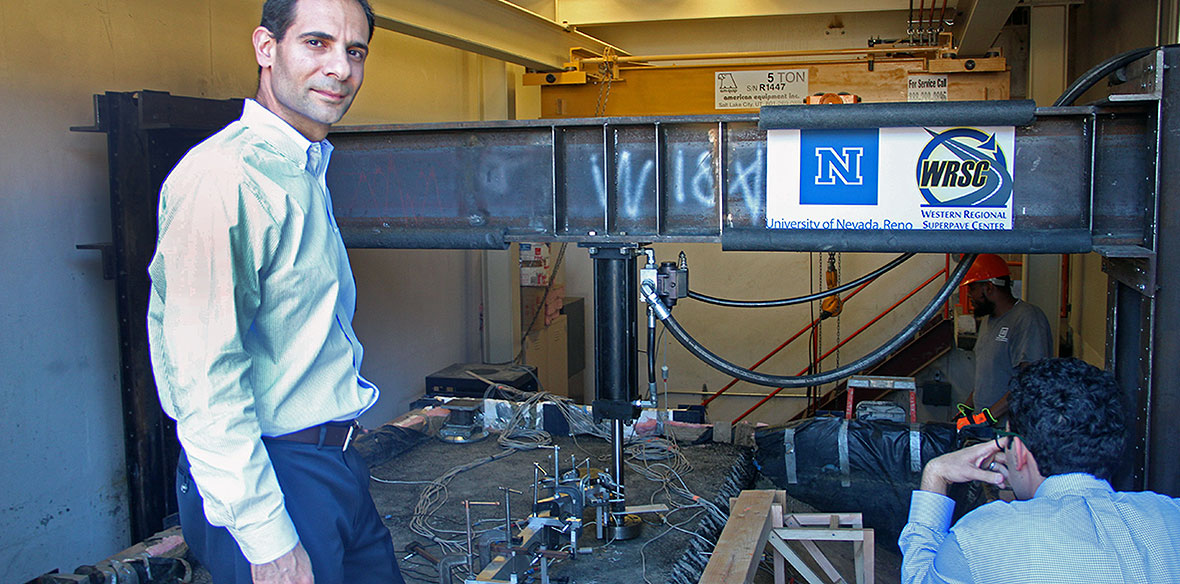Millions of miles driven by superheavy trucks on the nation's roads take a large toll on the ribbons of pavement crisscrossing the country. The cost of repairing and maintaining the highways that have seen vehicles carrying millions of pounds, even up to six million pounds, has been difficult to quantify all across the country, so the Federal Highway Administration has asked the University of Nevada, Reno to run experiments to find out what will actually happen when flexible pavement is subjected to that amount of force.
"This is important data that will help establish a fair and just fee structure that represents the true damage caused by truck loads of 250,000 pounds and heavier," Elie Hajj, associate professor and engineer with the Western Regional Superpave Center in the Department of Civil and Environmental Engineering at the University of Nevada, Reno, said. "The full-scale pavement tests went very well, we have gigabytes of information to process, which will yield highly useful data."
The experiments held on June 3 in the large-scale pavement test lab included dynamic testing to simulate rolling weights and static testing to simulate vertical force on asphalt pavement, which is the material used on 2.5 million miles, or 90 percent, of the nation's roadways.
The live testing simulated the force of a truck on a typical pavement structure with a slopped shoulder, which is considered to be critical when moving such a superheavy load. It will be compared to previously used computer models and integrated into policies and fee structures to help local, state and federal agencies to more accurately assess the impact of the massive loads that travel on the nation's roads.
The large, computer-controlled hydraulic ram pushed a 12-inch diameter steel plate onto the pavement in several locations, simulating the weight of one superheavy wheel on pavement.
"The static tests were scaled up from 9,000 pounds to 27,000 pounds and ultimately to destruction," Hajj said. "We saw damage begin with large and diverse cracks in the base and subgrade material, then distortion of the pavement surface followed by cracks in the asphalt."
The findings and recommendations of the various parts of the Superpave Center's research will be incorporated into a custom-built software developed by the team that can be used by any road agency in the country to assess the impact of superheavy loads on pavements.
In Nevada, there have been about 1,400 trips in the past 10 years with weights carrying more than 250,000 pounds, with the largest being 6.2 million pounds. This number of trips is much higher in states like Texas and Louisiana.
"Highways are typically designed for weights of 80,000 pounds and less, which are by far the most abundant vehicles on our roads," Hajj said. "The federal government and other states will make good use of this data to assess the most accurate damage incurred by superheavy loads so that proper mitigations can be made. With shipping and warehouse facilities a large portion of the Nevada economy, it will be important for our state as well."
A cost-allocation process is being developed by the team which is based on quantifying the extra load-related long-term damage caused by the superheavy load as compared to that caused by a standard truck. In this FHWA funded project the team is applying several techniques to achieve the objective of the research: laboratory testing, full-scale pavement testing, advanced analysis, pavement damage, and cost allocation studies.
"It's our goal to make it possible to develop statewide, and even route specific, simple and convenient guidelines that depend only on easily obtainable information such as vehicle loading data, axle/group weights and axle spacing," Hajj said.
The need to move superheavy loads on the nation's highways is a vital economic necessity for many important industries such as chemical, oil, electrical and defense. In Nevada, most of the superheavy loads are attributable to construction equipment and materials, to a lesser extent mechanical and electrical equipment and about 4 percent in mining and oil.
The Western Regional Superpave Center, one of only five such FHWA established centers in the country, works on this and a number of research projects to improve pavements in Nevada and around the country, including asphalt and concrete pavement testing, software analysis tools used around the world, a national research database and super heavy load research - all in the department's five labs dedicated to pavement and materials research.
"Our Pavement program exemplifies both excellence and high productivity, is conducting research critically important for our state and the nation and has earned a well-deserved international reputation," Manos Maragakis, dean of the College of Engineering said.












